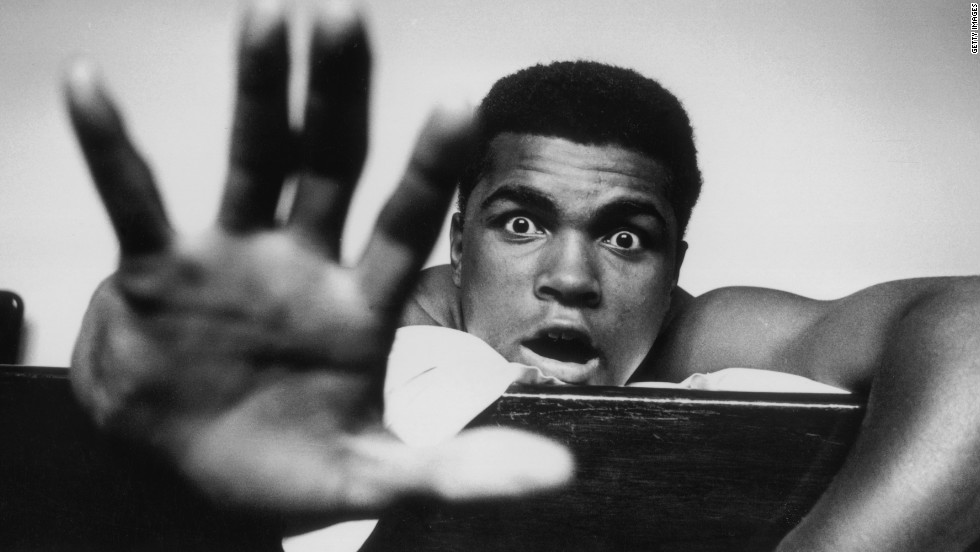1) Takes up boxing after his bike is stolen (1954)
If it wasn’t for the lure of free food, Muhammad Ali may never have boxed. As the 12-year-old Cassius Clay he pedalled on his red and white Schwinn bike to the Louisville Home Show, an exhibition for black businesses, for the free popcorn, hot dogs and candy. But when he left, his bike was gone. A stranger suggested he speak to a policeman, Joe Martin, at the nearby Columbia gym. As Ali later related in his autobiography, The Greatest: “I ran downstairs crying but the sights and sounds and smell of boxing excited me so much that I almost forgot about the bike.” As Clay left, Martin tapped him on the shoulder. “By the way, we got boxing every night, Monday through Friday, from six to eight. Here’s an application in case you want to join.”
2) Wins his first bout – and is hailed a future world champion (1954)
Clay was no out-of-the blocks natural. The first time he stepped into the ring, against an older fighter, he flailed wildly and within a minute his nose was bloodied and he had to be pulled out. As Martin put it, he “didn’t know a left hook from a kick in the ass”. But six weeks later the 6st 9lb Clay won his first bout by split-decision against another novice, Ronny O’Keefe, on Martin’s TV show Tomorrow’s Champions, which was shown all over Kentucky. Afterwards his father Cassius Clay Snr proclaimed: “My son is going to be another Joe Louis. The World Heavyweight Champion, Cassius Clay!”
3) Gold at the Rome Olympics (1960)

Clay nearly didn’t travel to the Olympics because he was so afraid of flying, and he even bought a parachute from an army surplus store to wear on the plane. After comfortable victories in his opening three bouts, Clay found the 1956 bronze medallist Zbigniew Pietrzykowski harder to fathom in the final, struggling with his opponent’s southpaw stance before winning a unanimous verdict. Later, in his autobiography, he claimed to have thrown his gold medal into the Ohio River, saying: “A few minutes earlier I had fought a man almost to death because he had wanted to take it from me … now I had thrown it in the river. And I felt no pain and regret. Only relief, and a new strength.” It was fiction. The truth was more mundane: he lost the medal.
4) Clay meets the wrestler Gorgeous George (1961)
After turning professional, Clay won six fights in six months. Then, on a Las Vegas radio show to promote his seventh contest, he met the wrestler ‘Gorgeous’ George Wagner, whose promotional skills got audiences coming to watch. As Ali later told his biographer Thomas Hauser: “[George] started shouting: ‘If this bum beats me I’ll crawl across the ring and cut off my hair, but it’s not gonna happen because I’m the greatest fighter in the world.’ And all the time, I was saying to myself: ‘Man. I want to see this fight’ And the whole place was sold out when Gorgeous George wrestled … including me … and that’s when I decided if I talked more, there was no telling how much people would pay to see me.”
5) Clay becomes a boxing Nostradamus (1962)
Ali soon started correctly predicting the round of victory – there was a run of seven times out of eight where he got it right – and when, in February 1962, he stopped Don Warner in four rather than the five forecast, he claimed he had finished the fight early because Warner had not shaken hands. Such promotional skills were paying off. When the boxing writer AJ Liebling arrived at Madison Square Garden 30 minutes before the first preliminary bout to Clay’s fight with Doug Jones he was shocked to find sold out signs and people being turned away.
6) Shows his heart against Henry Cooper (1963)
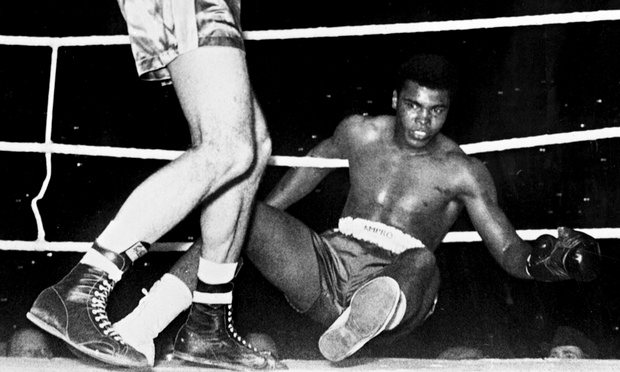
lay sauntered into Wembley like a monarch, with a gown emblazoned with ‘Cassius the Great’ and a crown encrusted with imitation diamonds. And, having predicted Cooper would fall in five, Ali preferred slow death by a thousand cuts. But with five seconds remaining of the fourth round, Cooper swung a left hook – Henry’s Hammer – that smashed Clay flush. Clay was down and up as the bell sounded. But he was still groggy as Angelo Dundee, his trainer, alerted the referee to a tear in his glove and a cornerman poured ice over Clay’s lower extremities. No spare gloves were available, but the delay gave Ali had a few extra seconds to recover. A brutal attack ripped Cooper’s face to shreds and the fight stopped in the fifth – as forecast.
7) Earns himself a fight with Sonny Liston (1964)
Clay was fast, handsome and quick-tongued but he was also brave. Just before the second Sonny Liston v Floyd Patterson fight in 1963, Clay followed Liston to Vegas and, after watching him lose at craps, shouted to him: “Look at that big ugly bear, he can’t do anything right.” The promoter Harold Conrad told Thomas Hauser what happened next: “So Liston throws the dice down, walks over to Clay, and says: ‘Listen here you nigger faggot. If you don’t get out of here in 10 seconds I’m gonna pull that big tongue out of your mouth and stick it up your ass’.” Clay was scared. He walked. But later he drove to Liston’s house in Denver to holler at him from his driveway. Shortly afterwards the fight was signed. Ali had his world title shot.
8) “I shook up the world” – Clay wins world heavyweight title (1964)
Liston was a boxing dementor, those soulless eyes draining hope from opponents’ before his fists stole their consciousness. In 36 fights he had lost just once – and even then, after having his jaw broken, he didn’t quit. At the weigh-in, Clay’s pulse was double his normal rate. People thought he was scared. But as he explained to his doctor Ferdie Pacheco he had a plan: “Liston is scared of no man, but he is scared of a nut because he doesn’t know what I am going to do.” He soon found out. Clay was slicker and sharper and, after surviving a torrid fifth when some oil of wintergreen on Liston’s gloves set his eyes on fire, forced his opponent to quit at the end of the sixth. Afterwards Clay told reporters he had “shook up the world … I am the greatest! … I am the prettiest thing that ever lived!” He was 22.
9) Cassius Clay becomes Muhammad Ali (1964)

After the earthquake, the aftershock. Clay’s interest in the Black Muslims began in 1959 when he saw a man in Louisville selling newspapers shouting: “Muhammad speaks! Read it!” But it was only in March 1961 that he visited a temple and became deeply immersed in the religion. As Pacheco put it: “Until Ali came into camp the Black Muslims were considered a fringe lunatic group … [but] Ali understood you did not fuck with the Muslims. He liked their strength.” Clay held off announcing his conversion because he didn’t want to jeopardise his fight with Liston. But days beforehand his angry father, Cassius Clay Snr (who claimed the Black Muslims had threatened to kill him) confirmed that his son – later to be Cassius X, then Muhammad Ali – had indeed joined the Nation of Islam.
10) Ali shows his nasty side (1965 and 1967)
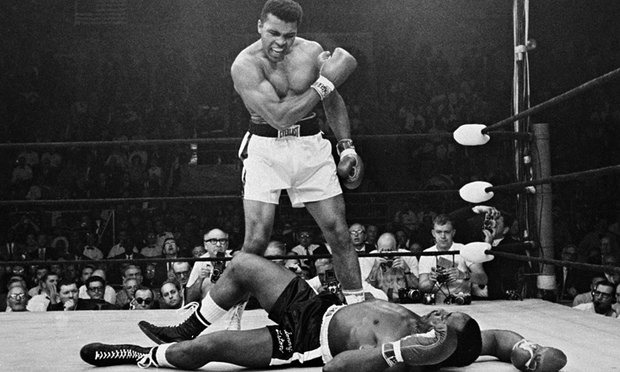
After knocking out Liston in the first round of their rematch – a robust discussion continues over whether Liston, a mob fighter, took a dive – Ali faced Patterson, who had told Sports Illustrated: “The image of a Black Muslim as the world heavyweight champion disgraces the sport and nation.” Ali responded, first with his tongue – Patterson was “nothing but an Uncle Tom Negro” – and then by torturing him for 12 rounds. In 1967, when Ali fought Ernie Terrell – who had referred to him Cassius Clay – he was just as vicious, demanding “What’s my name?” when he hit him on the way to a decision. The writer Jimmy Cannon claimed: “It was a bad fight, nasty with the evil of religious fanaticism. This wasn’t an athletic contest. It was a kind of lynching.”
11) “I ain’t got no quarrel with them Vietcong” (1966)
Ali had twice sat and failed a military exam in 1964 – his army IQ score of 78 was well below the level required to be drafted. “I said I was the greatest not the smartest,” a stung Ali retorted. But in early 1966 the army relaxed their standards, leaving him eligible for the draft. After hours of questions from reporters, asking him where he stood on the Vietnam War, Ali erupted: “Man, I ain’t got no quarrel with them Vietcong.” White America, who already hated him for being a Black Muslim, now accused him of being a draft dodger too.
12) Ali takes the heavyweight belt out of America (1966)
In five decades, from when Jack Johnson had lost his title to Jess Willard in Havana in 1915 to 1966, the heavyweight title had been contested only twice outside America. Yet with Ali finding it hard to fight in the US, he took his belt on the road: travelling to Canada to beat George Chuvalo, then to England to dispose of Henry Cooper – again – and Brian London, before hopping to Germany to beat Karl Mildenberger. As Boxing Illustrated acknowledged: “He is a fine goodwill ambassador in foreign lands, well loved by the boxing public, who care nothing for his private beliefs.”
13) The Ali shuffle is unveiled (1966)
When Ali returned to America, he produced one of the great visual performances of his career, stopping Cleveland ‘Big Cat’ Williams in three rounds – although Williams, who had lost a kidney and needed four operations after being shot in 1964, was an already broken shell. Ali knocked him over four times and debuted a series of blurring foot moves – the Ali shuffle – which he claimed was the hottest dance sensation since The Twist. Few now doubted his dominance. As Boxing Illustrated put it: “Many members of the press corps have found ways and means to find fault with Ali – he can’t punch, he can’t take a punch, he is too flashy, he makes a lot of amateurish mistakes. Anything to keep from giving his due … few doubters remain.”
14) Banned from boxing and thrown into jail (1967-68)
“How can I kill somebody when I pray five times a day for peace,” asked Ali, as over a few feverish months in 1967, he was stripped of his heavyweight title and banned from boxing for refusing to join the US Army. A year later he had a 10-day spell in the Miami Dade County Jail, for driving without a valid license, where he served food to death row inmates. “The odour of urine and faeces is so strong I want to hold my nose,” he wrote. “The first man recognises me: ‘Well, I’ll be goddamned! They got the world heavyweight champion coming for dinner. The world must be ready to come to an end!’” The philosopher Bertrand Russell wrote to tell him: ‘The air will change. I sense it.” And it did. But it took until June 1970 before the supreme court ruled Ali could fight again.
15) The Fight of the Century (1971)

By the time Ali came out of exile the public’s mood had shifted. As the boxing historian Jim Jacobs put it: “The exile … showed people that Ali was sincere. It made him an underdog. He became a symbol to people who had never been interested in boxing.” But it had eroded his skills. At Madison Square Garden, Ali and the new champion Joe Frazier threw everything at each other. But Ali was not quite as elusive or sharp, and increasingly Frazier caught up with him, before a left hook putting Ali on his pants in 15th round. It was the moment, as Norman Mailer put it, that Ali was “dumped into 50,000 newspaper photographs … singing to the siren in the mistiest fogs of Queer Street.” He got up but lost a unanimous decision.
16) Wins back title in The Rumble in the Jungle (1974)
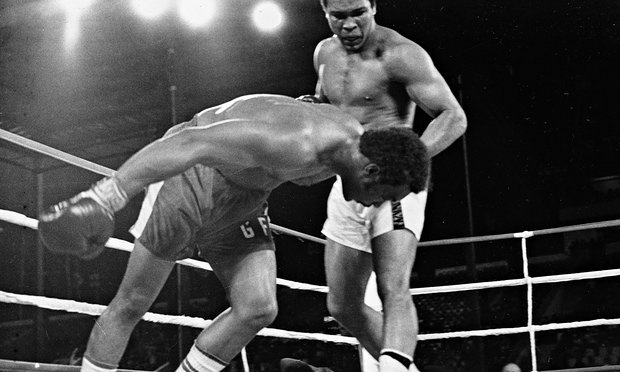
Even Ali’s extended family of hangers-on didn’t expect him beat George Foreman. Sensing the mood in his dressing room he asked: “What’s wrong around here? Everybody scared? Scared? A little thing like this? This is like another day in the gym.” Foreman had destroyed Frazier in two rounds, and set out to dismantle the 32-year-old Ali in much the same way. But Ali sat back on the slack ropes – the famous ‘rope-a-dope’ – inviting Foreman to expend his energy before picking him off. By the sixth Foreman was exhausted with, as Mailer put it, “lumps and swellings all over his face, his skin equal to tar that has baked in the sun.” With 20 seconds remaining of the eighth, Ali unfurled a chain of punches and Foreman twirled and flopped and fell. On commentary David Frost announced: “The great man has done it! This is the most joyous scene ever seen in the history of boxing!”
17) Thrilla in Manilla (1975)
Before their first fight, Ali had called Frazier “The wrong kind of Negro. He’s not like me, ‘cause he’s the Uncle Tom. He works for the enemy.” Before their third fight, he was just as spiteful, calling Frazier “a dumb ugly gorilla”. The fight, held in the broiling 10am heat, was – depending on your view – either a brutal classic or, given what became of both men later, painful to watch as they slugged each other to a standstill. Ali was on top early, Frazier rallied but with his eye closed, he took a beating in the 13th. At the end of the 14th, Frazier’s trainer Eddie Futch stopped the fight, telling him: “No one will forget what you did here today”. Ali later claimed that this was the closest to dying he had ever been.
18) Ali becomes a three-time heavyweight champion (1978)
By now Ali was 36, but in fighting years he was even older. In one of the more unmotivated performances of his career, he had lost his title to Leon Spinks, a seven-fight novice. But a few months later he was a little less plodding as he won the rematch to become the first man to hold the heavyweight belt for a third time. Afterwards Ali promised he would retire, adding: “I suffered and sacrificed more than I ever did. There’s nothing left for me to gain by fighting.”
19) A horrible night against Larry Holmes (1980)
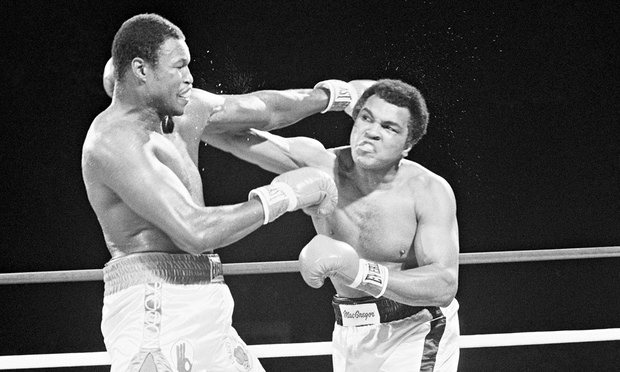
But like so many fighters, Ali couldn’t keep away. He signed up to fight Holmes, his former sparring partner and now the new champion, and having taken huge quantities of diuretics he looked the part entering the ring. But as Ali admitted afterwards, the drugs had drained him: “In the last two days I couldn’t jog a mile. I was dead tired after one round and there were 14 more to come.” At the end of the tenth, his trainer Angelo Dundee wanted the fight stopped, but Ali’s chief hanger-on Drew ‘Bundini’ Brown, fought for it continue. Dundee won out. Ali, head bowed, didn’t have the energy to protest. He had not won a single round on the judges’ cards.
20) Atlanta – and reappraisal (1996-present day)
Not everyone has bought into the Ali-as-saint narrative: in his book Ghosts of Manilla, the acclaimed writer Mark Kram claimed: “Ali was no more a social force than Frank Sinatra. The politically fashionable clung to his racial invective as if it were the wisdom of a seer. Today, such are the times, he would be looked upon as a contaminant, a chronic user of hate language and a sexual profligate.” Yet when Ali was revealed as the person lighting the Olympic flame in Atlanta, his left hand involuntarily shaking because of Parkinson’s disease, the crowd reaction – sustained noise, tears, and a huge outpouring of love – showed just how much Ali was now revered.

